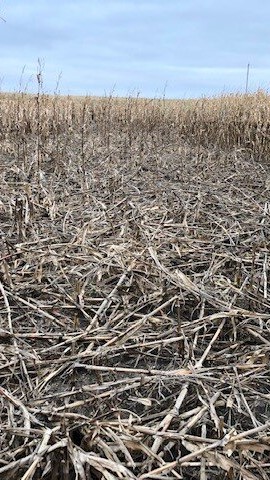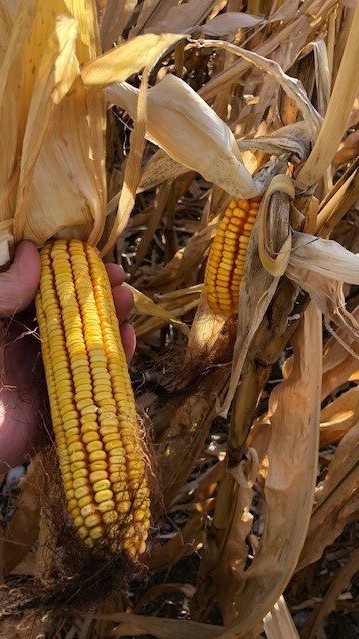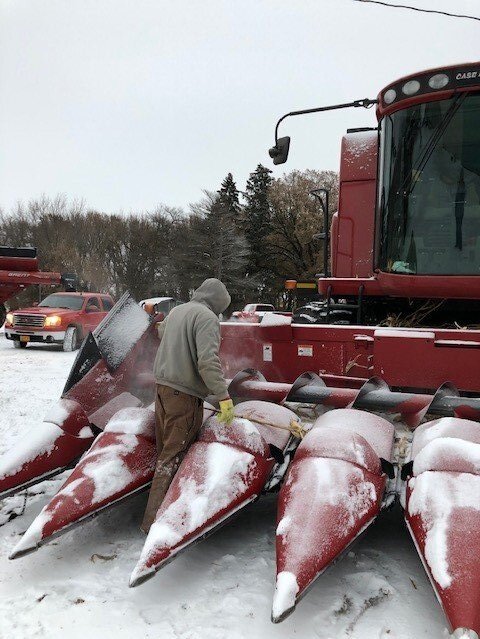Farm Life Journal - November 2019
November 18, 2019
By Tom Oswald
November: It’s on wheels.
When you raise the combine head at the end of the last swath of the last field of the last of the crop to be harvested, you can finally say “it’s on wheels.” Late afternoon on Nov. 14, Susanne and I put the last of our 2019 crop “on wheels.”
 There is still work to be done – bins to finish off, corn to deliver, equipment to move and clean up – but the worry wall for the production side of the 2019 crop is over. Wind, precipitation, field fire (in dry years), or critters like Bambi the deer or Rascal the raccoon can no longer do damage. It’s a weird feeling. It’s something you look forward to from the start of harvest.
There is still work to be done – bins to finish off, corn to deliver, equipment to move and clean up – but the worry wall for the production side of the 2019 crop is over. Wind, precipitation, field fire (in dry years), or critters like Bambi the deer or Rascal the raccoon can no longer do damage. It’s a weird feeling. It’s something you look forward to from the start of harvest.
Questions like: How’s it going to yield? What’s the harvest weather going to be like? Breakdowns? Early mornings? Late nights? Hopefully, no injuries other than skinned knuckles or banged up knees (there’s a hookup point on one of my grain augers that hasn’t been kind to my right shin).
You really don’t know what to expect other than just about anything can happen. Then it’s over. Within minutes of “on wheels,” I can feel tension exiting my body. You don’t realize you have been wound up like a watch spring until you start to feel the spring unwind. It seems like you get in a mental fog with one objective in mind… just ask my wife. Then, you go through a bit of let down once all the fall work is complete.
A farming friend from a large family farm diagonally across the state once made the comment, “You try to anticipate all that could go wrong and try to make sure it doesn’t happen.” Even then, there are still so many things out of your control.


Then it’s over. It’s on wheels. I know some farmers who say, “When I get done, I wish I had another 160 acres to do.” Yes, there’s truth in that especially if you do custom work and are looking to generate some more cash with your equipment. That’s true when you’ve had a perfect (seldom happens) harvest season and are done early with great weather in the forecast.

But that’s not true this year. Working mostly alone, it’s been tiring. When Susanne helps with the grain cart it’s nice to have someone else around to pick up my spirits. I’m not complaining or using the age card (60 ugh!) because I know a lot of guys and gals in farming who have had some seriously tough going this fall. They’ve had more snow, rain or cold than we’ve had. The cold, snow and ice wear a guy out... I am really tired of pulling on insulated bibs every day!
The propane shortage is tough in a year that most of the corn cannot be stored using only air to condition the grain to safe storage moisture. I know some farming operations that were really constrained on their harvest pace, not because of lack of equipment or labor, but rather lack of timely propane to keep their drying system running.
Years ago, when profitability was better, many farmers invested in upgraded grain handling and drying capacity. Many put in high capacity grain dryers to handle the size of their harvest equipment, acreage/bushels, and efficiency. Many new grain systems are more energy-efficient and technologically advanced, so advanced that they can be operated and monitored via smartphone from the combine seat. Running 24/7, these grain dryers are complex systems with a lot of things operating at once.
As you drive through the countryside, those bright shiny steel bins are quite an asset. I know some farmers who can take delivery of semi-loads of propane direct from the terminals. Even if you contract energy, you still need to get it on time. This year was tough for some.
I had to use more propane to dry corn than I have in a decade, but my co-op was able to keep up. Our gas-fired grain dryer is old. It does a good job but is slow compared to my potential harvest rate. When I bought my combine new in 2012, it was the smallest machine Case IH made. It’s capable of filling over 2 semi-trucks with corn in an hour. A hundred years ago, it would have taken 20 men a day to pick what my “small” combine can do in an hour.
We’ve moved to more natural air grain drying over the years, so we didn’t invest in upgraded (heat) drying capacity. This works fine until you hit a year when the crop comes off the field wet or a crop that is wet and high yielding. This crop was delayed, but it turned out alright. It was just more challenging.
Natural air drying means you use large fans to blow air through the bins without burning fuel to heat the air. When done properly, it makes for really nice grain quality coming out of the bins. It is simple because you don’t have to monitor a lot of equipment… just the fans. However, you need decent weather conditions to get “good air” (lower humidity, nice temperatures) for natural air drying.
 “Good air” is hard to find once you get to November. My neighbor to the east, who is one of the toughest 80-something-year-old guys still farming that I know, talks of his dad who used to say, “A day in October is worth two in November,” which is so often true. Once it gets cold or damp, the ability to condition grain with air diminishes rapidly, be that in the field or in the bin. If you don’t have “good air,” running fans for a month watching the electric meter spin like crazy does you no good in lowering grain moisture.
“Good air” is hard to find once you get to November. My neighbor to the east, who is one of the toughest 80-something-year-old guys still farming that I know, talks of his dad who used to say, “A day in October is worth two in November,” which is so often true. Once it gets cold or damp, the ability to condition grain with air diminishes rapidly, be that in the field or in the bin. If you don’t have “good air,” running fans for a month watching the electric meter spin like crazy does you no good in lowering grain moisture.
I have some corn binned that I’m going to manage with natural air and will really need to monitor it. In some cases, you can air-dry grain in the spring then move it to market. We haven’t done that in the past, but I might have to this year.
Many don’t realize how important our grain handling and storage infrastructure is until you visit with farmers from other countries who don’t have that asset. When I was the president of the Iowa Soybean Association, I had a memorable conversation with a woman from Africa during World Food Prize Week. People from all over the world were in Des Moines for the activities surrounding the event. As part of the activities, I was a host on a bus for a farm visit.
As the Iowa farmers we visited were harvesting soybeans and conveying them into the grain bins, this woman (I forget her title but can’t forget her incredibly bright and colorful dress for this farm tour) was really interested in the grain bins. She understood the farmers were using an auger to put the soybeans into the bin but didn’t understand how they got them out. I showed her where the unload auger was and explained.
Then she asked the unforgettable question… “How much spoilage do you have?” I said, if done properly, we use fans to condition the grain and seldom see spoilage. Plus, we have winter when we can essentially refrigerate or freeze the grain with the cold air. Her face then changed from a look of curiosity to one much different as she said “You mean those big silos seldom spoil? We seldom can keep from losing a third of our crop to spoilage and insects… how many more (people) we could feed if we could have losses as low as yours!”
What I’ve learned over the years of being an active farmer and in service to agriculture on farm organizations is that farming and agriculture is part of a much, much bigger food or utilization chain. Once my crop is “on wheels” it has real value (not estimated value) and contributes to a much bigger world pile. Around the world people then pull from the pile. It’s a fluid thing. It moves and relocates with demand and economic key drivers.


Some people think biofuels made from crops take food away, but what they may not realize is that biofuel will never out-compete food demand. Biofuels are a way to utilize excess and diversify the energy complex. People forget that in the past millions of acres were used to grow crops to be consumed by work animals like horses, mules, or oxen. Those were biofuel crops, too.
A friend in Arkansas I serve with on the United Soybean Board noted a saying his dad has, “We utilize soil and water to support plants to harvest carbon dioxide and sunlight, producing something that hopefully people need or want.”
Once it’s on wheels, the next step is moving it into the value chain. I do my best with marketing and storage to hopefully add a little more profit into the equation. I can’t make the 2019 crop yield better once it’s on wheels. Production of 2019 crop has ended. On to 2020. I’ve got seed dealers wanting orders for 2020 and payment for cash discounts. The cycle doesn’t end.
May your Thanksgiving holiday be a fine one. We’ll miss Mom, I know that. We always give thanks coming off a safe harvest.
Until next time,
Tom
